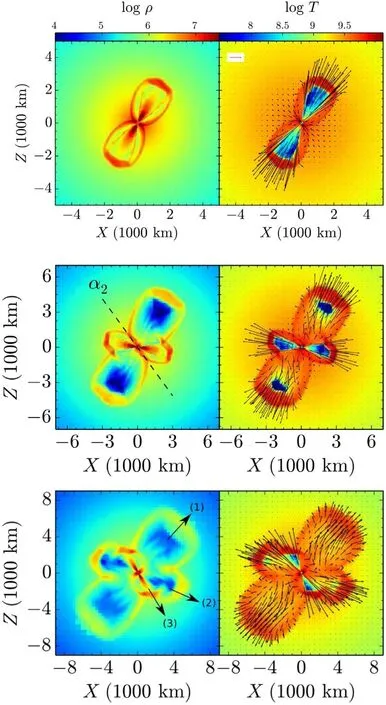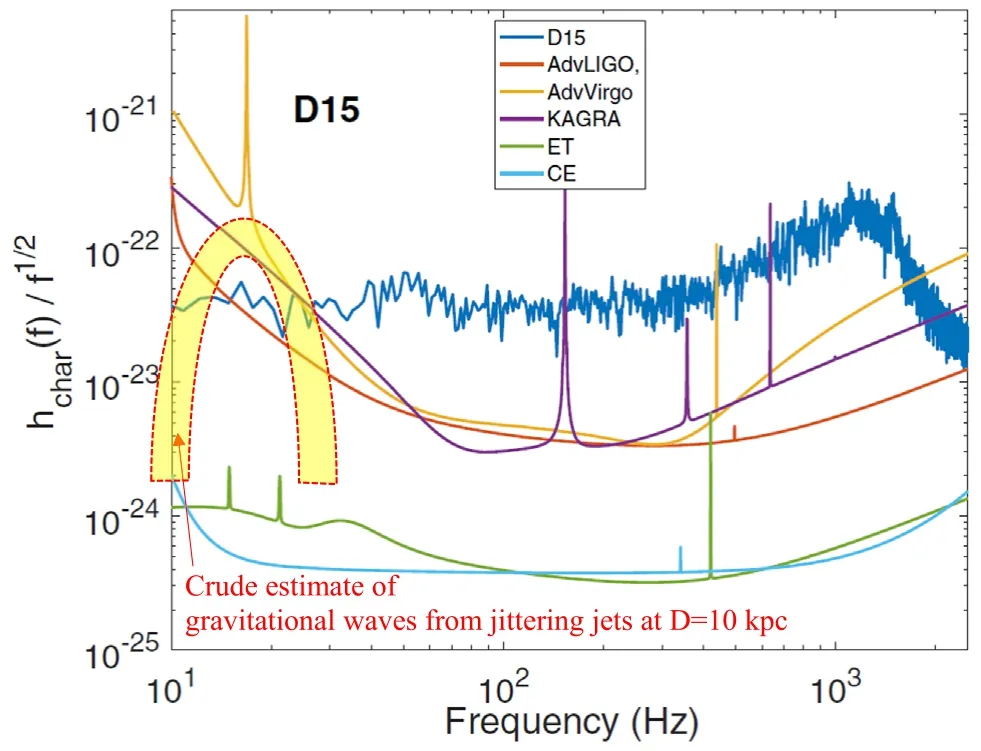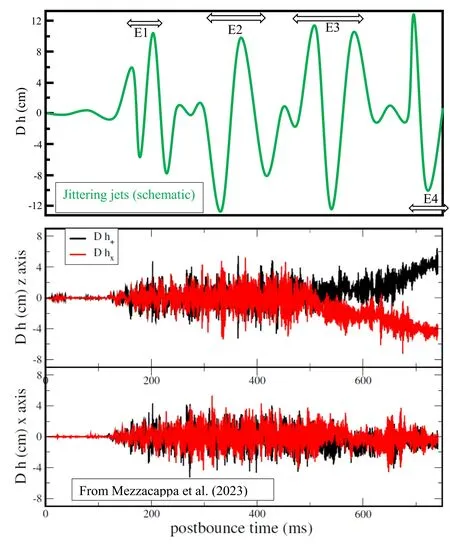Predicting Gravitational Waves from Jittering-jets-driven Core Collapse Supernovae
Noam Soker
Department of Physics, Technion, Haifa, 3200003, Israel; soker@physics.technion.ac.il
Received 2023 August 11; revised 2023 September 23; accepted 2023 October 7; published 2023 October 26
Abstract I estimate the frequencies of gravitational waves from jittering jets that explode core collapse supernovae(CCSNe)to crudely be 5–30 Hz, and with strains that might allow detection of Galactic CCSNe.The jittering jets explosion mechanism (JJEM) asserts that most CCSNe are exploded by jittering jets that the newly born neutron star (NS)launches within a few seconds.According to the JJEM, instabilities in the accreted gas lead to the formation of intermittent accretion disks that launch the jittering jets.Earlier studies that did not include jets calculated the gravitational frequencies that instabilities around the NS emit to have a peak in the crude frequency range of 100–2000 Hz.Based on a recent study, I take the source of the gravitational waves of jittering jets to be the turbulent bubbles(cocoons)that the jets inflate as they interact with the outer layers of the core of the star at thousands of kilometers from the NS.The lower frequencies and larger strains than those of gravitational waves from instabilities in CCSNe allow future,and maybe present,detectors to identify the gravitational wave signals of jittering jets.Detection of gravitational waves from local CCSNe might distinguish between the neutrino-driven explosion mechanism and the JJEM.
Key words: gravitational waves – stars: neutron – stars: black holes – (stars:) supernovae: general – stars: jets
1.Introduction
Since the early days of gravitational wave detectors, core collapse supernovae (CCSNe) have been considered as potential sources of gravitational waves (, de Freitas Pacheco 2010), with intensified research in recent years (,Afle & Brown 2021; Gill et2022; Saiz-Pérez et2022).Gravitational waves from CCSNe are yet to be detected (,Szczepańczyk et2023).Recent studies concentrate on the expected gravitational waves from CCSNe during the explosion process (, Powell & Müller 2019; Lin et2023;Mezzacappa et2023;Pastor-Marcos et2023;Wolfe et al.2023;for more on the results of some studies see Section 3)and shortly after explosion,, in relation to magnetar formation(, Cheng et al.2023; Menon et al.2023).
Studies that calculate the properties of gravitational waves from CCSN explosions ignore the role of jittering jets.The goal of this exploratory study is to estimate the expected contribution of jittering jets to gravitational wave emission from CCSNe.The motivation for this study results from recent studies that support the jittering jets explosion mechanism (JJEM) of CCSNe (,Soker 2022a, 2022c, 2023b; Shishkin & Soker 2023), and the very recent study by Gottlieb et al.(2023) who found that the turbulent cocoons that energetic relativistic jets form can be a strong source of gravitational waves.A cocoon is the convective bubble that a jet inflates, even if not relativistic (, Izzo et al.2019), and is filled with the shocked jet’s material and the shocked ambient material.Gottlieb et al.(2023) simulated relativistic and very energetic jets, ≈1052–1053erg, that are relevant to rare CCSNe where the pre-explosion core is rapidly rotating and the collapsing core is likely to form a black hole.There are many studies of such rare CCSNe that have fixed-axis jets; some do not consider gravitational waves from jets (e.g.,Khokhlov et al.1999; Aloy et al.2000; Maeda et al.2012;López-Cámara et al.2013; Bromberg & Tchekhovskoy 2016;Nishimura et al.2017; Wang et al.2019; Grimmett et al.2021; Gottlieb et al.2022; Perley et al.2022; Urrutia et al.2023a; Obergaulinger & Reichert 2023), while others do (e.g.,analytically Segalis & Ori 2001; Du et al.2018; Yu 2020;Leiderschneider & Piran 2021 and numerically Urrutia et al.2023b;Gottlieb et al.2023).The results of Gottlieb et al.(2023)are suitable to apply to the JJEM.
In this study, however, I deal with non-relativistic jets where each jet-pair has a much lower-energy of ≈1050erg.The JJEM asserts that such jets explode most CCSNe (e.g., Soker 2010;Papish & Soker 2011; Soker 2020; Shishkin & Soker 2021;Soker 2023a).The newly born neutron star (NS), or in some cases a black hole,launches the jets as it accretes mass through an accretion disk.There are two sources of the angular momentum of the accretion disk (e.g., Soker 2023a).These are pre-collapse core rotation that has a fixed angular momentum axis, and the convective motion in the pre-collapse core (e.g., Papish &Soker 2014b; Gilkis & Soker 2015; Soker 2019; Shishkin &Soker 2022) or envelope (e.g., Quataert et al.2019; Antoni &Quataert 2022, 2023) that has a stochastically varying angular momentum axis.When the pre-collapse core angular momentum is low the accretion disk has rapidly varying axis direction.Each accretion episode through a given accretion disk lasts for a limited period of time and leads to one jet-launching episode of two opposite jets.A recently released James Webb Space Telescope (JWST) image hints at a point-symmetric structure in the ejecta of SN 1987A,as predicted by the JJEM(Soker 2023c).
The convective fluctuations serve as seed perturbations that are amplified by instabilities behind the stalled shock,which is at ⋍100−150 km from the newly born NS.Namely, the same instabilities that give rise to gravitational waves in the frame of the neutrino-driven explosion mechanism (e.g., Mezzacappa et al.2020),which does not include jets,exist also in the JJEM.The JJEM has in addition the jittering jets that inflate turbulent bubbles (cocoons) that might emit gravitational waves according to the new results of Gottlieb et al.(2023).Note that the jittering jets in the JJEM result from the termination of accretion disks and the formation of new accretion disks.This is different from the jittering around a precession angle of a long-lived accretion disk as studied by, e.g., Katz (2022).
In the present, still exploratory, study I present the first prediction, although very crude, for gravitational waves in the frame of the JJEM.I do this by appropriately scaling the recent results that Gottlieb et al.(2023) obtained for gravitational waves from much more energetic jets than the jittering jets(Section 2).I then present the general characteristic of the strain of JJEM-driven CCSNe (Section 3).I summarize the results(Section 4)and strongly encourage simulations of gravitational waves from jittering jets in CCSNe.
2.Estimating Gravitational Waves from Jittering Jets
The calculation of gravitational waves by CCSNe as expected in the JJEM requires very demanding three-dimensional hydrodynamical simulations.In this preliminary study I make crude estimates by scaling the results of Gottlieb et al.(2023) whoconduct simulationsof long-lived relativistic jets with energieserg.
In the JJEM the jets are relatively short-lived and have a typical velocity of 0.3–0.5c (e.g., Papish & Soker 2014a;indeed,Guetta et al.2020 claim that neutrino observations limit the jets in most cases to be non-relativistic).In an explosion process there are ≈5–30 jet-launching episodes, with a typical activity time of each episode of⋍0.01–0.1s,anda typicalenergy ofthe two jets in each episodeoferg(Papish & Soker 2014a).
Gottlieb et al.(2023)estimate the range of frequencies of the gravitational waves when the jets’axis is at a large angle to the line of sight (off-axis) to be betweenandwhere △tjcis the time the jets energize the cocoons, csis the sound speed, and △rshis the width of the shell formed by the shock.For their simulations, this range is≈0.1–2000 Hz.The on-axis emission, i.e., when the jets’ axis is at a very small angle to the line of sight, has a strain amplitude that is more than an order of magnitude smaller than for the off-axis emission and the strain amplitude peaks at frequencies of 10–100 Hz.I note that the simulations by Urrutia et al.(2023b),who study gravitational waves from jets in gamma-ray bursts but do not concentrate on turbulence,yield different spectra and lower strains.

Figure 1.Density (left column with a color coding in logarithmic scale and units of g cm−3)and temperature(right column in log scale in units of K)maps at three times during the three-dimensional hydrodynamical simulation of jittering jets taken from Papish&Soker(2014b).There are three jet-launching episodes,each composed of two opposite jets,one episode after the other with activity times of 0–0.05 s in direction 1 in the lower panel, 0.05–0.1 s in direction 2,and 0.1–0.15 s in direction 3.I added double-lined arrows to point out the two opposite masses at the cocoon(bubble)head.While the first jet-pair inflates axisymmetric cocoons, the following cocoons largely deviate from axisymmetry.Velocity is proportional to the arrow length on the right column,with the inset showing an arrow for 30,000 km s −1.

Figure 2.A figure from Mezzacappa et al.(2023) to which I added a crude estimate of the characteristic spectrum of hf−1/2 from jittering jets in a CCSN at a distance of D=10 kpc(the horseshoe-shaped yellow zone).The signal in yellow is for one jet-launching episode.If several jet-launching episodes are considered to inflate only two opposite large bubbles(lower panel of Figure 1)then the strain will be larger, as it is about the sum of these episodes.Other marks are as in the original figure.The blue line is the calculation by Mezzacappa et al.(2023) of the characteristic gravitational wave strain from a CCSN of a 15M⊙stellar model.The five other lines represent the sensitivity curves of gravitational wave detectors: Advanced Laser Interferometer Gravitational Observatory (Advanced LIGO), Advanced VIRGO, and Kamioka Gravitational Wave Detector (KAGRA) that are current-generation gravitational wave detectors, and the more sensitive next-generation detectors,Cosmic Explorer and Einstein Telescope.The predicted full gravitational wave spectrum includes both the contributions from the regions near the NS that exist both in the JJEM and in the neutrino-driven explosion mechanism (blue line),and the contribution of the jittering jets.
To scale for one pair of jittering jets I consider the threedimensional simulations by Papish & Soker (2014b).They simulated three pairs of jittering jets that have their axes on the same plane, such that each jet-launching episode lasts for 0.05 s.In Figure 1 I present the density and temperature maps in the jittering plane of these jets.In each jet-launching episode the two opposite jets are seen as two opposite high density(red color on the left column) strips touching the center.While the first jet-pair inflates axisymmetric cocoons (bubbles), the second and third jet-pairs inflate non-axisymmetric bubbles.This is seen by the compressed gas at the head of the cocoon(bubble) that I point out with the double-lined arrows.

The relatively small ratio ofthat I find here shows that the typical spectrum of the gravitational waves of jittering jets is qualitatively different from the case that Gottlieb et al.(2023) study.In the case of the JJEM, I expect the spectrum to be in the narrow range of
As seen in Figure 1,the size of the cocoon is smaller than the typical wavelength of ≈20,000 km, which makes phase cancellation very small.
Scaling Equation(2) of Gottlieb et al.(2023) for the strain amplitude for one pair of jets out of many pairs in the JJEM gives
I also consider the following quantity that is used in the study of gravitational waves from CCSNe (e.g., Mezzacappa et al.2023)
where I scaled with the expected frequency range for jittering jets from Equation (1).
I note that Equations (2) and (3) treat each jet-launching episode as an independent event.If several episodes are considered to inflate only two opposite large bubbles (lower panel of Figure 1) then the energy in the scaling of the equations should be the sum of several jet-launching episodes.Namely, the scaling energy should be ⋍few×1050to ⋍1051leading to a strain larger by a factor of a few to ten.
3.Identifciation of Gravitational Waves from Jittering Jets
Several papers calculated the gravitational wave properties from CCSNe when jets are not included (e.g., Radice et al.2019; Andresen et al.2021; Mezzacappa et al.2023), i.e., in the frame of the delayed neutrino explosion mechanism (e.g.,Bethe & Wilson 1985; Heger et al.2003; Janka 2012;Nordhaus et al.2012; Müller et al.2019; Fujibayashi et al.2021;Boccioli et al.2022;Nakamura et al.2022;Olejak et al.2022).Mezzacappa et al.(2020), for example, find that lowfrequency emission, ≾200 Hz, is emitted by the neutrinodriven convection and the standing accretion shock instability in the gain layer behind the stalled shock,while high-frequency emission, ≾200Hz, is emitted by convection in the proto-NS.These studies find that the emission is mainly at frequencies of≈10–2000 Hz with larger strain amplitudes at frequencies of≈100–1000 Hz (e.g., Srivastava et al.2019).

Figure 3.The gravitational wave strain times distance as a function of time during the early explosion process.The upper panel is a schematic presentation of a possible waveform from jittering jets.The typical amplitude and frequency are according to Equations(2)and(1),respectively.The double-headed arrows present the contributions of four jet-launching episodes,E1–E4.The lower panel is from Mezzacappa et al.(2023)for calculations based on a simulation that does not include jets of an exploding stellar model of 15M⊙.
The gain region and the convection in the proto-NS exist also in the JJEM.Neutrino heating plays roles also in the JJEM(Soker 2022b).Therefore, the contributions of the gain region and the proto-NS to gravitational waves in the JJEM are similar to those in the delayed neutrino explosion mechanism.In the JJEM there is the additional contribution of the cocoons that the jets inflate in the core and envelope of the exploding star.In Section 2,I crudely estimated this contribution for jittering jets interacting with the core of the exploding star.In Figure 2, I present results from Mezzacappa et al.(2023).The result is of the characteristic gravitational wave strain from a CCSN in the frame of the delayed neutrino explosion mechanism of a 15M⊙stellar model.I added my crude estimate of a typical contribution of jittering jets as the horseshoe-shaped yellow region on the graph.The frequency range is by Equation (1)and the strain is by Equation (3) and with the same scaling.
The peak of the contribution of the jittering jets is at much lower frequencies than the peak of the other components of CCSNe.In addition, there will be variations with time as the jittering jets are active intermittently.As said, simulations of the JJEM are highly demanding because the calculations of gravitational waves require high-resolution simulations in order to resolve the convection in the cocoon and the head of the jetcore interaction.At this point I only present the possible schematic behavior of the strain as a function of time due to the contribution of jittering jets.In the upper panel of Figure 3, I schematically present such a gravitational wave signal due only to jittering jets.The frequency varies around ⋍16 Hz by Equation (1), and the typical value of the varying strain is by Equation(2)and with the same scaling.I describe the distance times the strain of four jet-launching episodes (but more are expected at a later time until the star explodes).Over the time period 0.2–0.7 s,the average frequency is 16 Hz.As commonly done, I take t=0 at the bounce of the shock wave from the newly born NS.There is some time delay until instabilities start to feed the intermittent accretion disks that launch the jets.These instabilities give rise to high-frequency-gravitational waves (e.g., Radice et al.2019; Andresen et al.2021).In the lower panel of Figure 3,I present one figure from Mezzacappa et al.(2023) that shows their calculation for the gravitational wave of a CCSN of a 15M⊙stellar model.The expected signal is the sum of all contributions.
My crude estimate of gravitational waves from jittering jets shows that their signal is qualitatively different than that of the other components that are close to the NS, ≾100 km.The jittering jets add long period modulations to the short-period waves from the other components.For a nearby CCSN, even the present Advanced LIGO detector might be able to separate the signal of the jittering jets from the other components.This depends on the signal-to-noise ratio that should be calculated with future simulations of jittering jets.Future detectors will be able to do so for CCSNe in the Local Group, at the same rate that they occur in the Local Group, about two CCSNe per century (e.g., Rozwadowska et al.2021).
4.Summary
Based on the very recent results by Gottlieb et al.(2023),which I scaled from long-lasting energetic relativistic jets in super-energetic CCSNe to short-lived low-energy non-relativistic jets in common CCSNe, I concluded that jittering jets lead to detectable gravitational wave signals.The source of the gravitational waves is the turbulence in the cocoons that the jets inflate (Figure 1).Whether present detectors can reveal the gravitational wave signals of jittering jets depends on the signal-to-noise ratio that simulations of jittering jets should calculate, and of course on the distance to the CCSN.Future detectors will be able to reveal the jittering jets signal from CCSNe in the Local Group (Figure 2), at a rate of about two per century.
The frequencies of the expected gravitational wave signals from jittering jets are lower than the other components of CCSNe, as I mark by the yellow horseshoe-shaped region in Figure 2.I schematically present a gravitational wave signal from jittering jets in the upper panel of Figure 3,and compare it with calculations from a CCSN simulation that includes no jets from Mezzacappa et al.(2023).The signal from jittering jets can be clearly distinguished from the other gravitational wave sources in CCSNe (depending on the signal-to-noise ratio and the distance of the CCSN).
This, still exploratory, study calls for the performance of highly demanding simulations of jittering jets and the calculation of their gravitational wave signals.The simulations must be of very high resolution as to resolve the turbulence in the cocoon.
Because I expect jittering jets to explode most CCSNe, my prediction for the gravitational wave signals from nearby CCSNe differs from the prediction of studies that include no jets.
Acknowledgments
This research was supported by a grant from the Israel Science Foundation (769/20).
ORCID iDs
 Research in Astronomy and Astrophysics2023年12期
Research in Astronomy and Astrophysics2023年12期
- Research in Astronomy and Astrophysics的其它文章
- Large-scale Dynamics of Line-driven Winds with the Re-radiation Effect
- A Study of Elemental Abundance Pattern of the r-II Star HD 222925
- Preliminary Study of Photometric Redshifts Based on the Wide Field Survey Telescope
- Solar Observation with the Fourier Transform Spectrometer.II.Preliminary Results of Solar Spectrum near the CO 4.66μm and MgI 12.32μm
- Density Functional Theory Calculations on the Interstellar Formation of Biomolecules
- Detection Capability Evaluation of Lunar Mineralogical Spectrometer:Results from Ground Experimental Data
